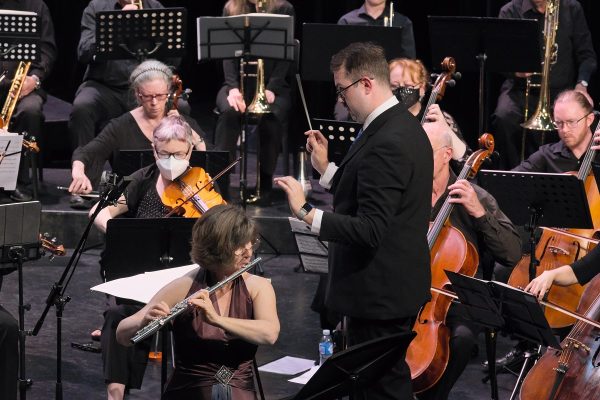
Music / “Brahms Symphony No. 2”, National Capital Orchestra. At The Q – Queanbeyan, November 13. Reviewed by ROB KENNEDY.
CONCERTS of cheerful music are not that common, but the National Capital Orchestra created a joyful experience when they performed Symphony No. 2 by Brahms to a large audience.
The National Capital Orchestra, under the baton of music director Louis Sharpe, began with “Overture No. 2” in D Major, by Emilie Mayer (1812-1883). This is one of 15 overtures Mayer wrote among many other works. It is a dramatic and bright piece.
Light and playful tunes were intermixed with solemn moments. Bright in nature with sparkling flute lines throughout, this was happy music. Under Sharpe’s conducting, the NCO can create a full, strong sound, and they did just that in this exciting opening piece.
“Night and Now”, Concerto for flute and orchestra, by Elena Kats-Chernin was commissioned by local flautist and ANU lecturer Sally Walker. In three movements, it’s Russian at its core. The soloist Teresa Rabe is well known in Canberra as she was the principal flute of the Canberra Symphony Orchestra and other local and national groups.

With a mysterious, soft and sad opening, this gentle music, full of great depth, was expressed wonderfully through the lilting melody from the flute. Somewhat cinematic in its scope, it contained sweeping music at a moderate pace and dynamic, this filled the first movement
The vibrant, speedy solo opening on flute for the second movement told that this section is where the action was going to be.
Rabe rarely got a rest in this movement. Her solo performance contained many tricky techniques, plus floating lines and playful passages, which created a sensational musical journey. The “Rondo” third movement which follows straight on was a lively dynamic section that ended in a flourish. The NCO was totally on song and sounded strong throughout.
After the interval, one of the most cheerful works of Brahms’ mature period, his “Symphony No. 2”, in D Major. It has a bright and sparkling character. The German symphonic repertoire is full of incredible works, and this symphony stands out through its joyful nature.
The first movement is the most serious. It’s also loud and full-on. Slower and quieter movements are where some amateur players can struggle. Unfortunately, several found it difficult to maintain a uniform intonation in the second movement. When the music built, the orchestra played as one and sounded exuberant. This is all a learning experience for some.
The third movement is a complete composition all on its own. Sprightly, complex and beautifully written, it contained some of the best playing of the day. The woodwinds shone.
The final section, full of action and volume is driven by rhythmic strength through new musical material. As it built towards the end of the final few bars, sweeping all before it away, the pounding timpani, and the whole orchestra created an incredible volume as the brass drove them all to a compelling finish.
Who can be trusted?
In a world of spin and confusion, there’s never been a more important time to support independent journalism in Canberra.
If you trust our work online and want to enforce the power of independent voices, I invite you to make a small contribution.
Every dollar of support is invested back into our journalism to help keep citynews.com.au strong and free.
Thank you,
Ian Meikle, editor




Leave a Reply